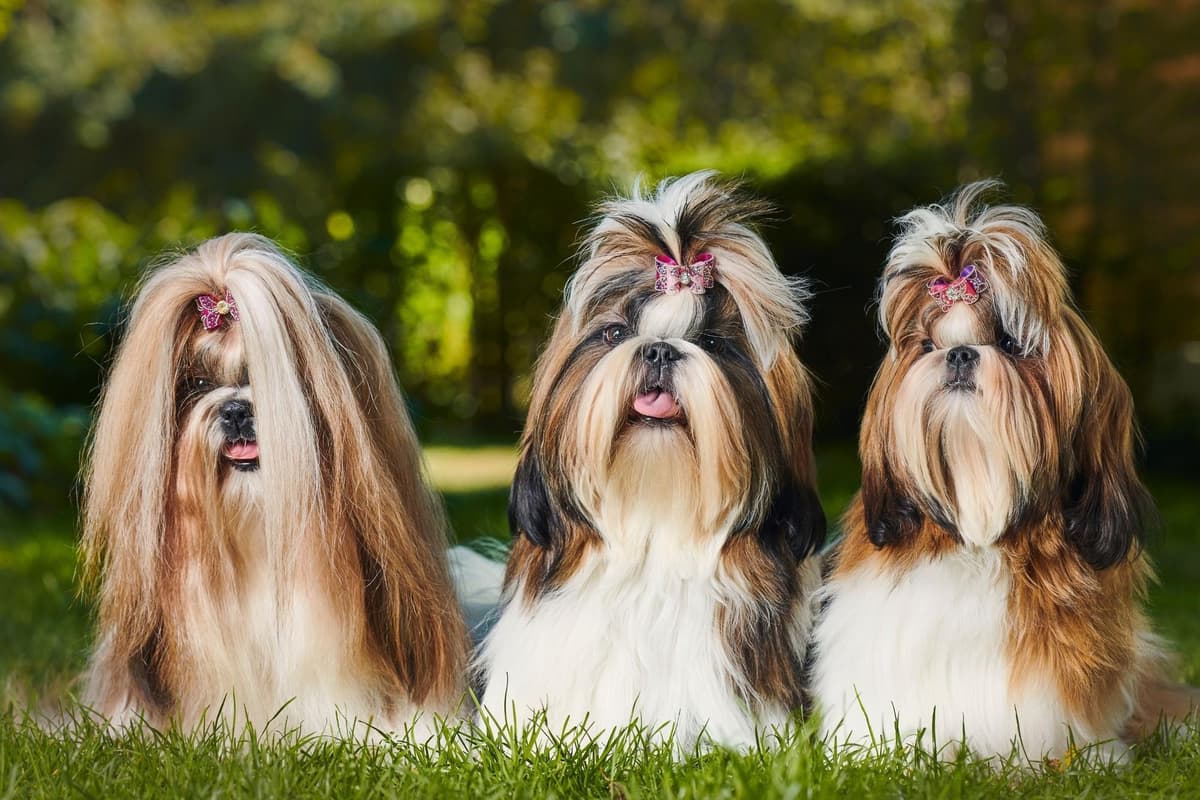Shih Tzus are small but powerful dogs with a luxurious, long, double-hair coat. This breed's alert, confident, playful, and adventurous personality makes it a favorite among toy dog fans. It is an ancient breed that has traditionally served as a lap dog for lords.
Hih Tzus can make excellent companions if properly trained and cared for. Because of its small stature, this breed is ideal for apartments and small living spaces. Because of its brachycephalic head shape and short, "smooshed" face, expect some snorting and snoring. Most owners would agree that their dog is a lovable breed.
Shih Tzu Dog Breed - Characteristics and Care Instructions
Shih Tzu in a Nutshell:
Shih Tzus are a charming and affectionate toy breed known for their long, fluffy coat, pushed-in face, and friendly demeanor. This Tibetan dog breed has gained popularity as a pet all over the world. They are a popular breed among dog owners because of their appealing appearance and ability to adapt to a variety of living situations.
Popularity Reasons:
Shih Tzus have won the hearts of many people for a variety of reasons.
They are endearing due to their long, flowing coats, expressive eyes, and distinct facial features.
They are known for their loving and lovable personalities. They usually get along well with children and the elderly.
Apartment-Friendly: Their small size and ability to adapt to indoor living environments make them an excellent choice for city dwellers and apartment dwellers.
Low Exercise Requirement: They don't require much exercise and are content with short walks and indoor play.
History
Where the Breed Originated:
Shih Tzus have been around for a long time. They were created to be companion dogs for Tibetan Buddhist monks. They were later given to Chinese emperors as gifts, and their fame spread to other royal courts. The name, which translates to "Lion Dog," is most likely a reference to their resemblance to Chinese guardian lions.
Differences Between Shih Tzu Breeds:
Shih Tzus do not have distinct "breeds" like other breeds of dogs. Dogs of the same breed may have different coat colors and markings.
Characteristics
Physical Description:
They are small but mighty dogs. They have a protruding nose, a long, flowing coat, and a plumed tail that falls over their back.
Personality Characteristics:
They are popular due to their gentle and kind nature. They require the happiness of others and enjoy being a part of their families' daily lives.
Temperament:
Shih Tzus are frequently friendly, lively, and watchful. They are friendly dogs who enjoy playing with people of all ages and getting along with other animals.
Size:
Shih Tzus are typically 8 to 11 inches (20 to 28 cm) tall at the shoulder.
Weight:
They usually weigh between 9 and 16 pounds (4 to 7 kg).
Lifespan:
They have a 10- to 16-year life expectancy. This is determined by factors such as heredity, food, and the overall health of the dog.
Socialization and education
Early education and socialization are critical:
They must be taught how to behave appropriately and get along with other people and animals from a young age. Getting the right amount of exposure to new people, places, and experiences can help people avoid being too shy or timid.
Methods of Training Suggestions:
The most effective way to train a Shih Tzu is through positive reinforcement. Treats, praise, and other forms of positive reinforcement are appealing to them.
Common Behavioral Problems and How to Solve Them:
Shih Tzus can develop bad habits if they are not properly socialized and trained. Separation anxiety, excessive barking, and resource guarding are all possible problems. These issues can be helped by regular exercise and mental stimulation.
Maintenance and upkeep
Common Illnesses and Symptoms:
Because of their flat features, Shih Tzus are prone to eye, tooth, respiratory, and joint problems.
Dietary Requirements:
It is critical that children consume a well-balanced, high-quality diet appropriate for their age, size, and level of activity. A consistent eating routine can help people maintain their weight and avoid becoming overweight.
Exercise Prerequisites:
They don't need much exercise, but they can benefit from daily brief walks and indoor activities to keep their bodies and minds active.
Hygiene and grooming:
Their coats are long and must be groomed frequently to avoid becoming matted and knotted. Their health is dependent on them brushing their teeth every day, bathing frequently, trimming their nails, and caring for their teeth.
Reproduction and breeding:
To be healthy and have good personalities, they must be responsibly bred. Health screenings and the production of healthy puppies are priorities for reputable breeders.
Where to Purchase and Adopt:
It is critical to purchase a Shih Tzu from a reputable breeder who prioritizes their pets' health and happiness. Purchase from puppy mills or individuals who breed dogs in their backyards. If you want to provide a loving home, you can also adopt from a shelter or rescue organization.
Popular Culture Shih Tzu
The well-known Shih Tzu:
Paris Hilton's famous Shih Tzu was named "Bit Bit." Nicole Richie and Billie Eilish are two other famous Shih Tzu owners.
Shih Tzus in Film and Television:
Shih Tzus have appeared in a number of films and television shows due to their cute appearance and friendliness.
Media Representation:
They are frequently portrayed as attractive and lovely pets in the media, which they are.
Conclusion
Finally, the Shih Tzu's appealing appearance, friendly demeanor, and adaptability have earned them a reputation as a popular pet. To ensure that these adorable puppies have a happy and healthy life, they must be properly taught and cared for from a young age, as well as have their medical needs met. With proper care, it can bring both joy and companionship to families and single people.
source https://dogcareguidetip.blogspot.com/2023/09/shih-tzu-dog-breed-characteristics-care.html


Post a Comment